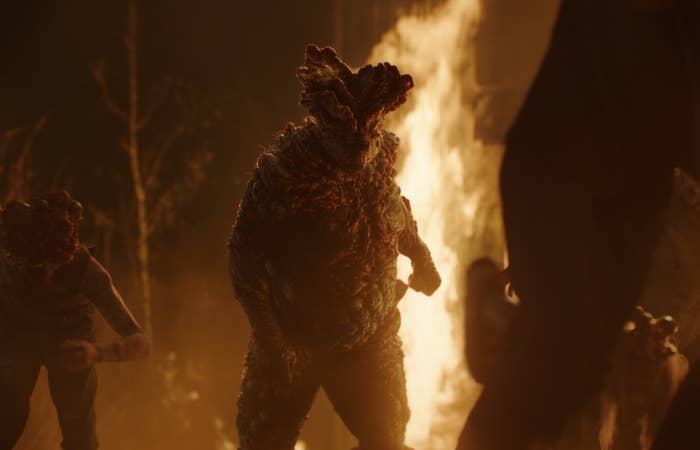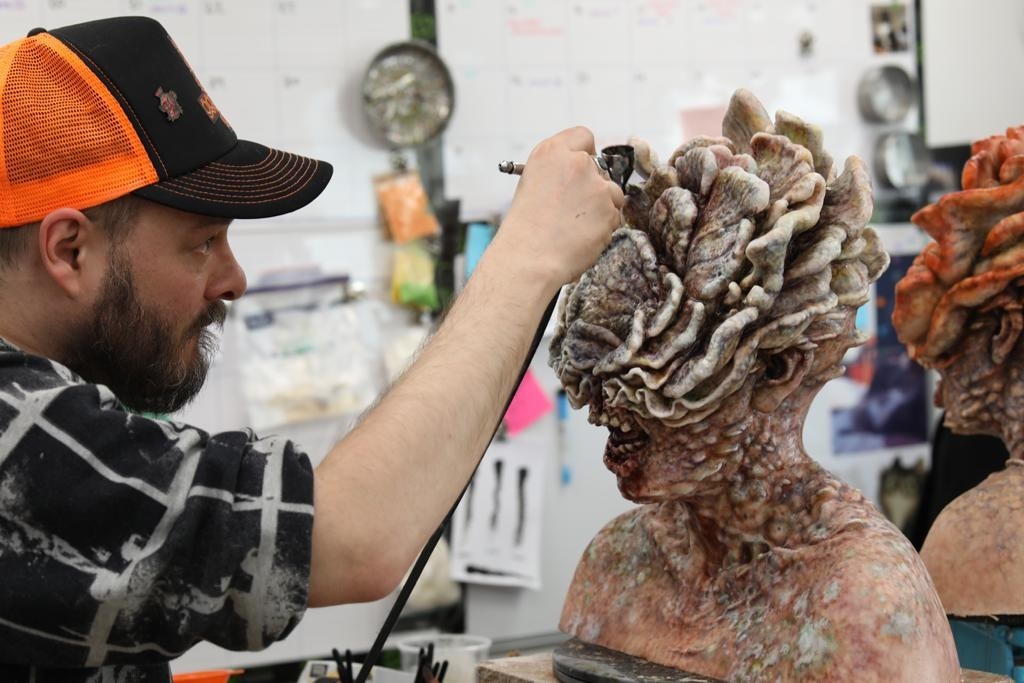
It took 60 actors and 70 prosthetic artists to create that major infected mob. In Episode 5 of HBO’s latest dystopian series, The Last of Us, which premiered Friday night, a swarm of infected fungal zombies save Ellie (Bella Ramsey), Henry (Lamar Johnson), Sam (Keivonn Woodard), and Joel (Pedro Pascal) from being held at gunpoint by Kathleen (Melanie Lynskey) and other armed rebels. They’re rescued only in the sense that now all the humans must fend for themselves against an infected army.
While the scene was intense — as a rampage of ruthless fungal zombies escape an underground tunnel — it was damn fun to shoot. “You've got people running around, you've got all these noises, you've got gunfire, [and] you've got a burning house in the background,” Samuel Hoeksema, an actor who played an infected in episodes 2 and 5, told BuzzFeed News. “It's these kinds of things that you dream of when you're going into this business. It really feels like it. It's crazy. It feels like some messed-up amusement park.”

There's been no shortage of zombie-esque creatures on TV, with the zombies in Black Summer, the undead in Game Of Thrones, and the walking dead in…The Walking Dead. But the infected in The Last of Us are different from their alive-but-not-alive TV forebears. Because they’re not just any old zombies, but arguably much worse.
In the series, a fungal infection, called Cordyceps, consumes most of mankind. The infection overtakes a human’s brain in the pursuit of spreading and spreading the fungus. Some of the infected eventually reach a later stage, in which the disfigurement leads to the skull splitting open, and become clickers. Other infected evolve long enough to become bloaters, which is when the fungus consumes the whole body and they essentially become giant monsters that sort of look like beautifully grotesque flora.

Creating the clickers and bloaters, however, wasn’t as simple as putting on a Party City mask and some fake blood. It required the fine-tuning of Barrie Gower, the Emmy-winning prosthetics genius behind Game of Thrones’ White Walkers and Stranger Things’ Vecna. The Last of Us presented a new challenge for the veteran. Unlike those other massive shows about the undead, The Last of Us came with visual source material: the widely popular video game series. So Gower, alongside showrunners Craig Mazin and Neil Druckmann, adhered to the video game version of the clickers as closely as possible.
“The last thing we want to do is not give the TV show enough fan service, and we don't want to disappoint people, especially [when] there are these beautiful designs,” Gower said.
The team largely depended on prosthetics, but some details were left for CGI, like the huge craters in the center of the clickers’ heads. They eventually got the prosthetics process down from an initial eight hours to an average of three to four for Hoeksema, including applying dentures to the front of the clicker’s lips and a large foam latex rubber crown. Gower said the team really put Hoeksema "through the wringer. I mean, he was covered in prosthetics.”
Adam Basil, the actor who plays a bloater in episode 5, also donned a giant rubber foam suit in addition to spending hours in the makeup chair.

“To actually throw that amount of weight around, when you're wearing a mattress pretty much, is really, really difficult,” Gower said of the foam suits.
And that was only half the battle. There’s also the acting.
Hoeksema met Bella Ramsey, Pedro Pascal, and Anna Torv the first time he wore the clicker suit on set. He recalls Torv saying she couldn’t even look at him.
“Once all the makeup is on, nobody can really see me, you know what I mean? And you feel like you're really in your own world,” Hoeksema said. “By the end, I really felt like I could just go nuts and do my thing.”
As frightening as the design and performances of the infected are in the show, luckily the real-life Cordyceps fungus does not compare. It primarily affects insects. So worry not, a clicker isn’t about to pop up at your door and turn you into a fungal zombie anytime soon.
“From a clinical infectious disease perspective, no pathogen causes such disfiguring appearance that the Cordyceps in the show appears to cause,” said Scott Roberts, associate medical director of infection prevention at the Yale School of Medicine. “I wouldn't lose, like, a wink of sleep about this.”
Hoeksema is loving the role. If it’s up to him, he’ll be back for Season 2, wreaking more havoc as a clicker, bloater, or whatever infected stage there is left.
“I would run around in that makeup for the rest of my life,” he said. “I mean, I'll do it in a wheelchair when I'm like 90 years old and be a geriatric clicker.” ●
